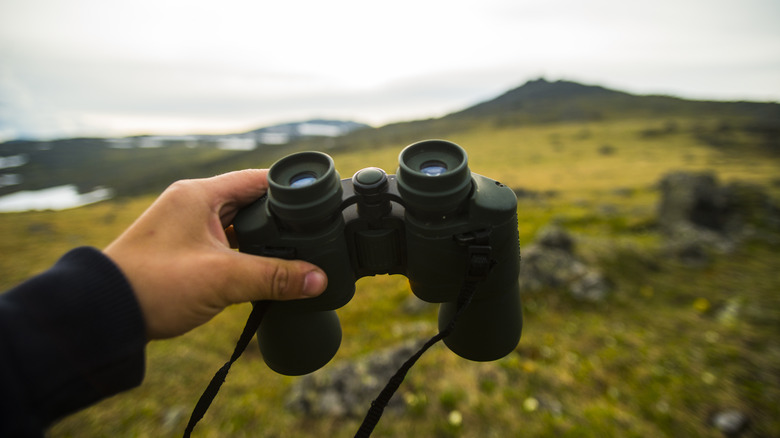What Do The Numbers On A Pair Of Binoculars Mean?
Whether you're in the market for a new pair of binoculars for yourself, searching for the perfect gift for the outdoors person in your life, or the proud owner of a stunning new pair, it's important to fully understand how this tool works.
A pair of binoculars is pretty straightforward: look through them, and things that were far away now appear closer. But anyone who has ever picked up a pair to find them out of focus or hard to use will tell you there's a lot of subtle nuance to binoculars, and thus there's a lot to learn about your specific pair. Luckily, you don't need to be an expert in any particular brand, you just need to understand what the numbers on a pair of binoculars mean and use that information to help make sure you're holding the right tool for the job.
On most binoculars, you'll find numbers that look something like "8x25," "10x25," or "15x56," for example. As you may have guessed, these numbers are important to the overall function of your binoculars.
What does the first number on binoculars mean?
The first number, the one before the "x," refers to the magnification of the binoculars. If you're holding a pair of 10x42, the ten tells you that objects viewed through those lenses will look ten times larger than they would if you looked at them with your naked eye.
Now, you may be thinking that means you want to go to the store and reach for the pair of binoculars with the highest magnification so you get the best bang for your buck, but that's not the right move. Instead, consider what you're using the binoculars for. Once you get past 10x magnification, everything, including the slightest shake of your hand, will be magnified significantly. You'll need a tripod or some other stabilizing apparatus to make these work effectively. So, if the task at hand is bird watching, for example, those critters tend to move, and you're going to maybe want only 8x magnification so you can track those movements.
Sadly for the online shoppers among us, the best way to figure out the right binoculars for your hobby of choice is to get some in your hand and give them a test. One easy solution that some people go to is getting variable binoculars, which offer the ability to zoom at multiple magnification levels. However, as with most things with more function, these tend to be a lot heavier and are often prohibitively expensive given all the extra parts required to make that work.
What does the second number on binoculars mean?
The second number, the one after the "x," refers to the objective diameter of the lens in the binoculars. This is the part of the tool that is responsible for gathering light and therefore affects the clarity of the image you see when looking through them. The higher this number, the brighter and sharper the image will be when you're out and about using your binoculars. Once again, it's tempting to simply reach for the highest objective diameter number. However, once again, price and weight suddenly become a big factor.
If you're looking to carry these in your backpack or take them on an adventure, the higher the objective diameter number you purchase, the heavier the pair of binoculars will be and, since the lenses are more difficult to craft, you're looking at spending more than you need for simple use in an everyday hobby. And how mad will you be if they get damaged?
Additionally, the objective diameter number tends to go up as the magnification number goes up. So, the above-mentioned pitfalls of a high magnification number may also impact your decision to opt for a higher objective diameter pair of binoculars.
What does the field number mean on binoculars?
Many binoculars may have a third number below the magnification and objective diameter, listed in degrees or feet. That number is the field of view, and it's exactly what it sounds like. This refers to the area (in the mathematical sense) you can view when looking through your binoculars. Because it's directly related to magnification, the higher you go on that scale, the lower your field of view gets. It makes sense when you think about it. The binoculars help you focus on a single area, which cuts out a lot of the surrounding views.
This number is typically expressed in feet or in angles. For example, if it reads "FIELD 6.4°" the degree symbol tells you what you're dealing with and some simple math can tell you that you'll be able to see in a 336-foot area. However, this number can vary depending on the brand of binoculars you purchase, so it's worth consulting the product guide to determine the units of measurement used for the pair you're looking at.



